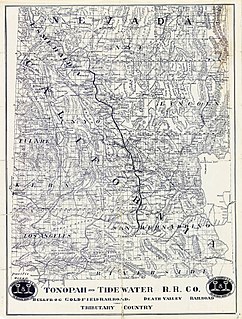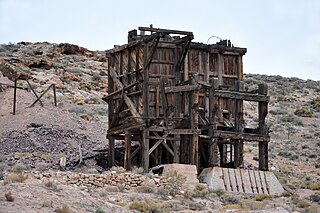
Dewey–Humboldt is a town in Yavapai County, Arizona, United States. The population of the town was 3,894 according to the 2010 census. The Dewey–Humboldt area was a census-designated place (CDP) at the 2000 census, at which time its population was 6,295.

Indian Springs is an unincorporated town and a census-designated place near Creech Air Force Base in northwestern Clark County, southwestern Nevada.

Beatty is an unincorporated town along the Amargosa River in Nye County in the U.S. state of Nevada. U.S. Route 95 runs through the town, which lies between Tonopah, about 90 miles (140 km) to the north, and Las Vegas, about 120 miles (190 km) to the southeast. State Route 374 connects Beatty to Death Valley National Park, about 8 miles (13 km) to the west.

Tonopah is an unincorporated town in and the county seat of Nye County, Nevada, United States. It is located at the junction of U.S. Routes 6 and 95, approximately midway between Las Vegas and Reno. In the 2010 census, the population was 2,478. The census-designated place (CDP) of Tonopah has a total area of 16.2 square miles (42 km2), all land.

Rhyolite is a ghost town in Nye County, in the U.S. state of Nevada. It is in the Bullfrog Hills, about 120 miles (190 km) northwest of Las Vegas, near the eastern edge of Death Valley. The town began in early 1905 as one of several mining camps that sprang up after a prospecting discovery in the surrounding hills. During an ensuing gold rush, thousands of gold-seekers, developers, miners and service providers flocked to the Bullfrog Mining District. Many settled in Rhyolite, which lay in a sheltered desert basin near the region's biggest producer, the Montgomery Shoshone Mine.
This history of Las Vegas covers both the city of Las Vegas, Nevada and the Las Vegas Valley.

Scotty's Junction is an unincorporated community in the Sarcobatus Flat of Nye County, Nevada where State Route 267 meets with U.S. Route 95 at an elevation of 4,062 feet (1,238 m).

Nelson is a census-designated place in Clark County, Nevada, United States. The community is in the Pacific Standard Time zone. The location of Nelson is in El Dorado Canyon, Eldorado Mountains. The town is in the southeast region of the Eldorado Valley. As of the 2010 census it had a population of 37.

Delamar, Nevada, nicknamed The Widowmaker, is a ghost town in central eastern Nevada, USA along the east side of the Delamar Valley. During its heyday, primarily between 1895 and 1900, it produced $13.5 million in gold.

Gold Center was a mining town in Nye County, Nevada. Located in the Bullfrog Mining District south of Tonopah, Gold Center was established in December 1904 with a United States Post Office being authorized on January 21, 1905. The town began publishing its own newspaper in 1907. The location of the town was ideal as it was on the stagecoach route to Rhyolite and Beatty. It was also near the Amargosa River, allowing sufficient water for drinking and for two mills and an ice house. Gold Center also sold water to Rhyolite and Carrara. The Tonopah and Tidewater Railroad, the Las Vegas & Tonopah Railroad and the Bullfrog Goldfield Railroad all ran through Gold Center. Gold Center also had the first brewery in the area which was built underground to maintain a cool temperature.

Blair, Nevada is a mining ghost town in Esmeralda County, Nevada.

Nevada became the 36th state on October 31, 1864, after telegraphing the Constitution of Nevada to the Congress days before the November 8 presidential election. Statehood was rushed to help ensure three electoral votes for Abraham Lincoln's reelection and add to the Republican congressional majorities.

The Las Vegas and Tonopah Railroad was a 197.9 mile railroad built by William A. Clark that ran northwest from a connection with the mainline of the San Pedro, Los Angeles and Salt Lake Railroad at Las Vegas, Nevada to the gold mines at Goldfield. The SPLA&SL railroad later became part of the Union Pacific Railroad and serves as their mainline between Los Angeles and Salt Lake City.

The Tropicana Laughlin is a hotel and casino in Laughlin, Nevada. It is owned by Gaming and Leisure Properties and operated by Eldorado Resorts. The hotel has 1,498 guest rooms and suites, located in the 12-story Casino Tower and the 24-story Promenade Tower. The casino has 1,050 slot machines and 21 table games. It includes the restaurants: The Steakhouse, Passaggio Italian Gardens, Carnegie's Café, Taqueria Del Rio, Poolside Café, Dips & Dogs and Victory Plaza.

Bonnie Springs Ranch was an attraction near Blue Diamond, Nevada that included an 1880s western town replica and a zoo. It is located on 63.86 acres (25.84 ha) in the Mojave Desert, below the Spring Mountains in the Red Rock Canyon area, 20 miles west of Las Vegas. The ranch has natural oasis habitat, from the spring water surfacing there.

Pyramid is an unincorporated community in Washoe County, Nevada, United States. At one time, it was a station on the Fernley and Lassen Railway located between Bristol and Big Canyon. At one time there was a post office at this location.

Veteran is a ghost town in the state of Nevada. Located just west of the current town of Ruth, Veteran was the site of a tent city and mining town between 1906 and 1914, though the current site is abandoned.

The T&T Ranch was a demonstration farm and dairy, that was situated in the Amargosa Valley, 5.5 miles southeast of Leeland in Nye County, Nevada. It was owned by the Tonopah and Tidewater Railroad between its foundation in 1915 and the 1940s. During that time five pieces of land were added to the property, that were obtained under the Pittman Underground Water Act. The T&T Ranch was thereafter occupied by Gordon and Billie Bettles.

























